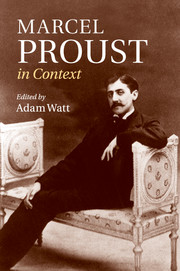Book contents
- Frontmatter
- Contents
- List of Illustrations
- Notes on contributors
- Figure I. Marcel Proust, portrait in oils by Jacques-Émile Blanche, 1892
- Preface
- Figure 2. Proust photographed on his death-bed by Man Ray, 1922
- Note on the text
- Chronology
- Part I Life and works
- Part II Historical and cultural contexts
- i. The arts
- ii. Self and society
- Chapter 14 Freud and psychoanalysis
- Chapter 15 Sexuality
- Chapter 16 Health and medicine
- Chapter 17 Technology and science
- Chapter 18 Religion
- Chapter 19 Travel
- Chapter 20 Journalism
- Chapter 21 Politics and class
- Chapter 22 The Dreyfus Affair
- Chapter 23 The First World War
- Part III Critical reception
- Further reading
- Index
- References
Chapter 23 - The First World War
from ii. - Self and society
Published online by Cambridge University Press: 05 November 2013
- Frontmatter
- Contents
- List of Illustrations
- Notes on contributors
- Figure I. Marcel Proust, portrait in oils by Jacques-Émile Blanche, 1892
- Preface
- Figure 2. Proust photographed on his death-bed by Man Ray, 1922
- Note on the text
- Chronology
- Part I Life and works
- Part II Historical and cultural contexts
- i. The arts
- ii. Self and society
- Chapter 14 Freud and psychoanalysis
- Chapter 15 Sexuality
- Chapter 16 Health and medicine
- Chapter 17 Technology and science
- Chapter 18 Religion
- Chapter 19 Travel
- Chapter 20 Journalism
- Chapter 21 Politics and class
- Chapter 22 The Dreyfus Affair
- Chapter 23 The First World War
- Part III Critical reception
- Further reading
- Index
- References
Summary
À la recherche du temps perdu as we know it is a product of the war. When the First World War broke out, in August 1914, Proust, who was forty-three, asthmatic, and in poor health (he would live only another eight years), had just published the first volume, Du côté de chez Swann (1913). At this point, the Recherche was in its author's mind only a trilogy, a Hegelian structure with a redemptive Aufhebung. To the notion of ‘lost time’ (in the first volume) would correspond that of ‘time regained’ (in the third volume). In between, Le Côté de Guermantes would be a sort of ‘crossing of the desert,’ time wasted rather than lost (‘perdu’ has both meanings), which in the end would be redeemed through Art, an episode called ‘Adoration perpétuelle’.
The overall structure, time lost/time regained, of the cathedral-like novel endured. But the volume in between, Le Côté de Guermantes, which was ready for the press, did not. A moratorium on publication prevented Grasset, then Gallimard from publishing it, and as the surprisingly long war extended the moratorium, it gave Proust time to dismantle this first Guermantes and reconstruct, expand and modify the middle section in ways he had not anticipated.
- Type
- Chapter
- Information
- Marcel Proust in Context , pp. 174 - 180Publisher: Cambridge University PressPrint publication year: 2013

